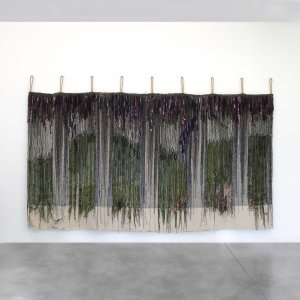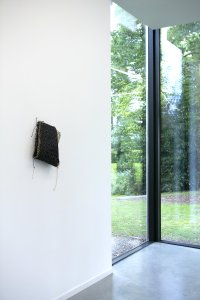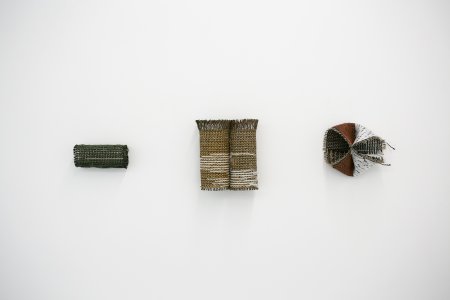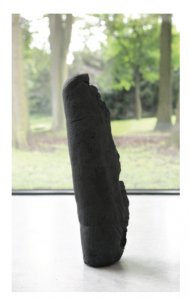Sporen van binnen en buiten - Remnants from inside and outside Jo Van Rijckeghem & Bram Van Breda Hilde Vandaele Gallery
A common theme in the art of Jo Van Rijckeghem and Bram Van Breda is their fascination for residual materials and their tactility. The closeness of the perceptible world around us, both inside and outside, and the way we relate to it, is their main source of inspiration. By using everyday objects and materials in their murals and tapestries, the artists seek to engage in a dialogue with the viewer. Objects and materials, firmly anchored in the here and now, which due to their everydayness we often fail to notice, the 'ordinary', but forgotten, things that are close to us, but at the same time distant. By revealing and (re)valuing the seemingly banal aspects of everyday life, the artists reconnect with the (outside) world. Van Rijckeghem and Van Breda combine and assemble various objects and materials in a quest for a dialogue with the viewer and the world around them.
For 20 years, Jo Van Rijckeghem (°1967) has been creating murals, multi-layered constructions in which, by combining various types of discarded materials, he creates new compositions. Referring to the word 'assemblage', which is derived from the French 'assembler' meaning 'to collect' or 'to put together', Van Rijckeghem collects, like a beachcomber, the things that he comes across. He combines, balances and is inspired by the countryside that surrounds him. The landscape, the rows of trees, the ploughed fields, these define the rhythm of his poetical imagery. He fashions sculptures with materials forgotten in the folds of time. They are remnants that have something to tell, that contain a history within and that appeal to the viewers' imagination due to their own memories. The act of contemplation by the viewer enables Van Rijckeghem's work to unfold and become complete.
The artist captures the countryside where he lives and works with an instinctive interplay of materials. He uses a combination of wood, brass, resin and rubber. These are materials that have been used by people throughout the ages, natural materials. For example, resin is produced by specific trees when the bark of their trunk is scarred and rubber is made from the sap of, among others, the Brazilian rubber tree. The warm golden yellow of brass is symbolic of the perfection, the unrivalled beauty of the sun. This material is frequently used in industrial applications, but also in interior decoration. In this way, Van Rijckeghem underlines the interplay between inside and outside, between nature and culture.
For this artist, the filthiest piece of wood is the most fascinating. Like that piece of tree that is over 500 years old. Van Rijckeghem first lets nature do its work and then manipulates these materials by scratching, chopping, burning and grinding. Referring to ploughed strips of farmland, the artist seeks to interpret nature's rhythm by such manipulation, which is a never-ending quest to find a balance between nature and culture. In his pursuit to achieve the ideal black colour, he burns wood and then mixes it with rubber. It reminds you of the thick, wet clay after heavy rain.
In his landscape paintings, Jo Van Rijckeghem expresses nature in its very essence, in a poetry of materials, in fertile and infertile fields that await the viewer's gaze.
For 'Sporen van binnen en buiten' ('Remnants from inside and outside'), Bram Van Breda (°1992) has created a large work, which he calls 'an impressionist painting made of textile'. Because, similar to Van Gogh, who determined his colour compositions with the help of coloured yarn, Van Breda made his textile painting in touches of colour. For this composition, he was inspired by the nature surrounding the pavilion, more specifically the trees. After all, the basis for this tapestry, a waste product of the textile industry, already featured some existing graphic drawings that reminded the artist of the trunks of the surrounding trees. By concentrating on the spatial aspect of the image, Van Breda explores the boundaries of the textile medium. When does textile become space? When does space become textile? And how can an image become space? Hung by loops from the wall, the landscape is removed from its context and presented as a memory, a souvenir, a setting for a play. It becomes a transportable image, in keeping with the tradition of the tapestry, which was carried from castle to castle in the olden days.
Van Breda also shows transparent mesh wall sculptures made with anti-insect netting or fly screens which are painted on both sides with spray paint. The artist cut the original sculpture in pieces and then reassembled it. Due to the properties of the material, the strips of netting bend and the sculpture tends to constantly change shape. From a distance, the works look like veils through which you can look outside, curtains as a partition between inside and outside, as a metaphor for the interplay of concealing and revealing. For it is only by concealing that one can look again at the world through the window. The mesh wall sculptures represent the reflection of the surrounding landscape in the large window of the pavilion, the shadow that enters, draws a pattern of stains on the wall.
'Le Corps Blessé' was made by the artist during a stay in a former coalmine factory in Liège. They are pitch-black sculptures made of coal sand, a waste product of the coal industry, fine dust that is released when cleaning the fossil fuel. Van Breda mixed this dust with water, wrapped it in textile and then pressed it while it was still damp. The manual act of wrapping gave the sculptures a physicality that contrasts with the inertness of coal. The structure of the textile created an imprint of fine lines, similar to human skin. This makes the sculptures look like amputated limbs, a reference to the landscape of Liège as a wounded body, the result of industrialisation. The stumps are dusty, heavy and yet light at the same time. They sparkle, because just like coal, they absorb the light and thereby integrate in the environment.
With his tactile materials, Bram Van Breda tries to move the viewers emotionally, to draw them closer. The soft coal dust, the caressing textiles, these stimulate the viewers' imagination and bring their attention back to the things in the here and now, of the inner and outer world. In this way, the artist turns the exhibition space into a world of sensory perception.








